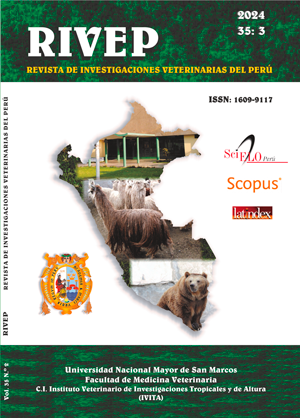Effect of tactile stimulation on the welfare of English Thoroughbred foals
DOI:
https://doi.org/10.15381/rivep.v35i3.25798Keywords:
horse, behaviour, human-animal interaction, temperamentAbstract
The aim of this study was to evaluate the effect of tactile stimulation on the behaviour, physiological indicators, and performance of Thoroughbred foals. The experiment was conducted at Haras Cerro Punta, Chiriqui, Panama. Thirty-three foals with homogeneous weights were randomly assigned to three treatments: control (CON; n = 13), tactile stimulation (TS; n = 10), and tactile stimulation plus habituation to handling for 8 consecutive days (TS + HAB; n = 10). Tactile stimulation was performed 12 h after birth by massaging the entire body of the newborn for 45 min. Habituation to handling started the day after touch stimulation, 15 min per day for 8 consecutive days. Behaviour was assessed using escape distance and reactivity to containment during veterinary interventions on a 5-point scale (1-5). In addition, heart and respiratory rates and daily weight gain were determined in the first and fifth months of age. Analysis was performed using linear mixed or nonparametric tests. The escape distance did not differ between treatments (p>0.05). TS+HAB animals showed lower reactivity during restraint at both times compared to CON (p<0.05). The respiratory rate only differed between TS+HAB and CON at the first moment (p<0.05). However, there were no significant differences in daily weight gain between the treatments (p>0.05). It was concluded that the foals that received tactile stimulation and habituation to handling for eight consecutive days (TS + HAB) had consistently lower reactivity throughout the evaluated moments and a lower respiratory rate at one month of age.
Downloads
Downloads
Published
Issue
Section
License
Copyright (c) 2024 Celina Aguirre, Joseph Grajales-Cedeño, Mayara Andrioli, Héctor Cedeño, Alex Ríos-Moreno, Reynaldo Vargas

This work is licensed under a Creative Commons Attribution 4.0 International License.
AUTHORS RETAIN THEIR RIGHTS:
a. Authors retain their trade mark rights and patent, and also on any process or procedure described in the article.
b. Authors retain their right to share, copy, distribute, perform and publicly communicate their article (eg, to place their article in an institutional repository or publish it in a book), with an acknowledgment of its initial publication in the Revista de Investigaciones Veterinarias del Perú (RIVEP).
c. Authors retain theirs right to make a subsequent publication of their work, to use the article or any part thereof (eg a compilation of his papers, lecture notes, thesis, or a book), always indicating the source of publication (the originator of the work, journal, volume, number and date).










